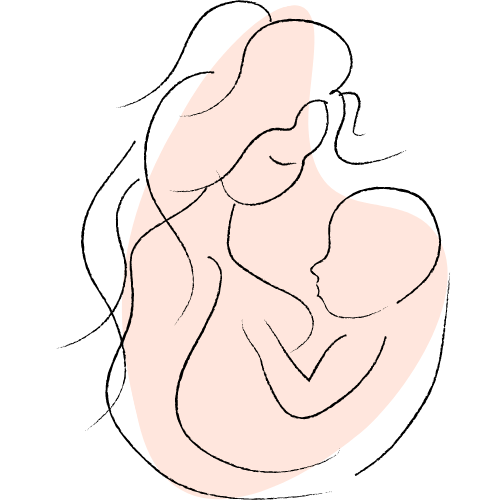Skin-to-skin contact after birth consists of placing the newborn on the naked body of its mother, avoiding unnecessary separation.
Skin-to-skin contact, also called the kangaroo method, involves placing the newborn on the naked body of its mother as soon as possible after birth. Indeed, there should be no separation between the mother and the baby in the moments which follow its birth. Care should therefore be taken to avoid unnecessary separation which could harm the infant.
First, we can distinguish different types of skin-to-skin contact (PPC). Skin-to-skin contact is immediate when it occurs immediately after birth. But there is also early skin-to-skin contact if it occurs within the first half hour after delivery.
Normally, after birth, the newborn is dried, identified, weighed, prepared and placed under a source of radiant heat. Today, more and more hospitals are creating their skin-to-skin contact protocol after birth. However, many routines put in place with newborns should be reviewed. Indeed, procedures that require separation should be banned. Separation should only be done if it is essential for the infant.
In the case of a eutocic delivery in which the newborn has an adequate Apgar, skin-to-skin contact with the mother must be made. This contact should not be interrupted as ocular prophylaxis and intramuscular administration of vitamin K can be performed up to two hours after birth.
In the case of caesareans, in some hospitals, skin-to-skin contact with the mother in the operating room is allowed. However, other hospitals allow the father or another person chosen by the mother to make this skin-to-skin contact.
History of the kangaroo method
The kangaroo method was initiated in 1979 by pediatricians Edgar Rey and Héctor Martínez, from San Juan de Dios Hospital in Bogotá. They created a care program for premature babies. Due to the lack of resources in their country, they designed this alternative to incubators, drawing inspiration from baby kangaroos.
They then found better life expectancy in developing countries using this method. In addition, they observed a reduction in the number of infections in the baby, easier breastfeeding and greater self-confidence on the part of the mothers.
In South Africa, this method was introduced by Dr. Nils Bergman (pediatrician and neonatologist) in the 1980s. He argues that the first minutes of life mark the rest of life.
“In the health field, the most expensive interventions are not necessarily the most effective. The mother’s body is the best machine ever invented! It provides nutrition, temperature, glucose, brain development, optimism and health at a lower cost. “
-Dr Nils Bergman-
Skin-to-skin contact is one of the 10 steps in the “Humanization of Childbirth and Breastfeeding Initiative” It has spread around the world and is supported by the United Nations Children’s Fund (UNICEF) and the World Health Organization (WHO).
Throughout human history, mothers have provided newborns with protection, warmth, social stimulation and nutrition. However, modern perinatal medical management requires early separation schemes between mother and baby.
Benefits of skin-to-skin contact
The results of various studies show that skin-to-skin contact is more beneficial than an incubator.
- First of all, skin-to-skin contact allows the newborn to integrate well into its new external environment. In fact, it improves oxygenation, stabilizes the heart rate and breathing. It also reduces the duration of crying.
Skin-to-skin contact stabilizes the temperature. - It increases the chances of successful breastfeeding and improves emotional ties. A study carried out in New York among 150 births of healthy, term and premature babies. The study concluded that, of the 72% of mothers who wanted to breastfeed, only 28% continued to breastfeed. Of these 28%, 100% had practiced skin-to-skin contact in the delivery room.
- In addition, it increases the level of oxytocin. Oxytocin has an anti-stress effect on the mother. Finally, it improves uterine contractility and promotes the ejection of colostrum.
- Finally, this contact promotes colonization of the newborn by maternal germs.
Effects of separation
The early separation of the mother from the newborn has a number of negative effects that should be avoided.
- This makes links more difficult. Separation slows the development of the mother’s smell recognition.
- In addition, it slows recovery from the stress of childbirth.
- It increases energy expenditure and slows the metabolic adaptation of the newborn. The separation causes hypothermia in the baby, which produces peripheral vasoconstriction. This results in increased consumption of glucose and metabolic acidosis.
- The baby sleeps less and cries more.
- Finally, it hinders the success of breastfeeding. Indeed, if we miss the sensitive period, the baby will not be able to reach the mother’s breast alone.
- In most animals, if you separate newborns from their mothers and reunite them later, the mother often rejects them. The female can even sometimes kill them. Similarly, a mother who has been waiting 9 months for a surge of love and maternal pride may feel discouraged and frustrated if she is separated from her baby. This is demonstrated later. In addition, birth stresses the baby. A stress from which he must recover. He needs his mother and familiar noises such as his breathing or his heartbeat to feel safe.
Prefer maternities practicing skin-to-skin contact
Finally, we cannot therefore neglect and disdain such a simple technique without additional financial cost which has as many favorable repercussions for the mother and the newborn. For this, it is therefore essential that all future mothers know the importance of skin-to-skin contact. It is therefore good to learn about the protocols in place at the hospital where they wish to have their children.
